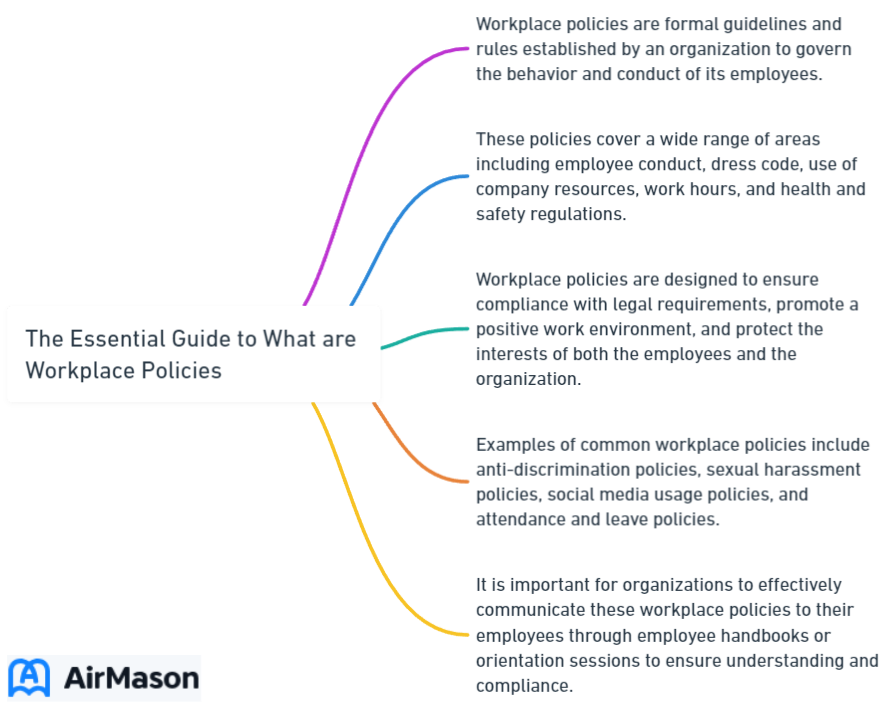
Have you ever wondered, what are workplace policies and how they shape your day-to-day work experience? These seemingly mundane guidelines play a vital role in creating a harmonious, productive, and legally compliant work environment. In this blog post, we will explore the intricacies of developing, implementing, and maintaining effective workplace policies, ensuring a respectful and professional atmosphere for everyone involved.
Key Takeaways
- Workplace policies are essential for setting expectations, promoting health and safety, and protecting organizations from legal liabilities.
- Organizations must adhere to relevant laws and regulations while consulting with employees during the development process.
- Effective implementation of workplace policies requires clear communication, monitoring compliance, suitable consequences for violations & regular review/updating.
Defining Workplace Policies
Workplace policies, or company policies, are the lifeblood of an organization, regulating employee conduct, maintaining a productive work atmosphere, and conforming to legal requirements. Putting company policies into practice, they encompass a wide range of topics, including:
- Health and safety
- Interactions with customers and colleagues
- Use of company resources
- Anti-discrimination and harassment
- Social media usage
- Attendance and punctuality
- Dress code
Policies are essential not only for setting clear expectations and guidelines but also for preserving the organization’s values and creating a positive work environment.
Averting legal proceedings and ensuring a safe work environment for all employees are the key benefits of implementing workplace policies. This can be achieved by meticulously defining key terms, outlining permissible and prohibited actions, and specifying the consequences of non-compliance. Employees should be properly informed about workplace policies and workplace procedures. This can be done through employee handbooks, training sessions, and regular communication from management. Staying current with these policies is vital for the smooth operation of the workplace.

Types of Workplace Policies
There are numerous types of workplace policies that cater to different aspects of employment and organizational culture. For instance, the code of conduct policy outlines the expected behavior and conduct of employees in the workplace, ensuring professionalism and consistency. Health and safety policies, on the other hand, aim to prevent workplace injuries and illnesses by outlining safety procedures and protocols.
Another example is the acceptable use policy, which governs the use of company resources and technology, such as internet usage and personal devices in the workplace. These policies are instrumental in maintaining acceptable behavior, a harmonious, professional, and legally compliant work environment, thereby contributing to the organization’s overall success.
No Recording Policy Template
In adherence to our commitment to maintaining a secure and respectful workplace environment, we have implemented a comprehensive “No Recording Policy Template.” This policy outlines the clear guidelines and expectations regarding the prohibition of audio, video, or any form of recording within company premises or during official business activities. By establishing this framework, we aim to safeguard the privacy, confidentiality, and trust essential for effective collaboration among our team members. Employees are encouraged to familiarize themselves with this policy to ensure a shared understanding of our commitment to creating a professional and secure work environment.
Legal Requirements
While some workplace policies are specific to organizations or industries, others are legally required by employment legislation. To avoid legal liabilities and maintain a positive reputation, it is crucial for organizations to comply with relevant laws and regulations. For instance, anti-discrimination laws mandate employers to ensure equal opportunities and prohibit discrimination, making equal opportunity and anti-discrimination policies legally required.
Organizations can maintain legal compliance by consulting legal counsel, implementing digital security measures, and creating channels for incident or near miss reports. Ultimately, adhering to legal requirements not only protects the organization from potential penalties or lawsuits but also fosters a fair and respectful work environment for all employees.
The Purpose and Importance of Workplace Policies

Workplace policies serve multiple purposes, including:
- Ensuring conformity with legislation
- Promoting health safety
- Preventing victimisation and preferential treatment
- Setting clear expectations and benchmarks for employees
By clearly ensuring that workplace policies communicate, employees are made aware of how the organization expects them to conduct themselves, perform their duties, and interact with their colleagues, ensuring appropriate employee behavior. This, in turn, fosters a harmonious work environment and minimizes the likelihood of workplace conflict.
Furthermore, workplace policies are pivotal in fostering fairness and inclusivity in the workplace. For instance, equal opportunity and anti-discrimination policies ensure that all employees are treated fairly, irrespective of their background or characteristics. By providing clear guidelines and expectations, workplace policies contribute to a positive work environment and promote best practices.
Compliance with Laws and Regulations
Workplace policies are a key tool for organizations, aiding them in adhering to state and federal regulations, ensuring legal compliance, and mitigating the risk of penalties or lawsuits. Adhering to these policies helps organizations avoid legal difficulties and sanctions, ultimately protecting their reputation and fostering a safe and compliant work environment.
To ensure compliance with workplace safety regulations, organizations should adhere to the health and safety procedures set forth by organizations like OSHA and implement safety policies outlining the correct procedures for potentially hazardous work tasks. By complying with relevant laws and regulations, organizations can maintain a safe workplace and minimize legal risks.
Creating a Positive Work Environment
Effective workplace policies contribute to a positive work environment by setting clear expectations, promoting fairness, and fostering a culture of respect and professionalism. By addressing issues such as sexual harassment and ensuring employees understand and adhere to these policies, misconduct can be reduced by up to 65%. This, in turn, fosters a positive work environment where employees feel respected, valued, and motivated to perform their best.
Establishing transparent policies for time off and leave can also play a significant role in creating a positive work environment, reducing potential misunderstandings and ensuring that all parties are well-informed. Ultimately, a positive work environment not only benefits employees but also contributes to the overall success and growth of the organization.
Developing Effective Workplace Policies

Creating effective workplace policies requires organizations to first pinpoint key areas and needs like compliance, workforce diversity, and health and well-being. It is essential to consider the organization’s specific goals, values, and culture when developing policies, as well as any legal obligations or industry-specific requirements. This ensures that the policies are tailored to the organization’s unique needs and contribute to a harmonious and compliant work environment.
Another vital aspect of formulating effective workplace policies is the inclusion of employees and stakeholders in the development process. By seeking input and feedback from various perspectives, organizations can develop policies that are well-received, relevant, and more likely to be adhered to. This collaborative approach not only fosters a sense of ownership and commitment among employees but also helps to identify potential areas for improvement and enhancement.
Identifying Key Areas and Needs
Identifying the organization’s specific needs and key areas is crucial for developing relevant and effective workplace policies. This involves considering aspects such as legal requirements and regulations, industry-specific guidelines, and organizational values and goals. For instance, organizations should ensure their policies address workforce diversity and inclusion, employee health and well-being, communication and technology, performance management, and conflict resolution.
By addressing these key areas, organizations can develop comprehensive policies that not only meet legal requirements but also contribute to a positive and supportive work environment. This, in turn, promotes employee engagement, satisfaction, and productivity, ultimately contributing to the organization’s overall success.
Involving Employees and Stakeholders
Consulting with employees and stakeholders during the policy development process is essential for creating effective workplace policies. This collaborative approach fosters a sense of ownership and commitment among employees, while also providing valuable insights and feedback that can help identify potential areas for improvement. By involving employees and stakeholders, organizations can create policies that are well-received and more likely to be followed, ultimately contributing to a harmonious and professional work environment.
Some effective methods for gathering employee feedback on workplace policies include:
- Annual employee engagement surveys
- Casual conversations
- Pulse surveys for real-time feedback
- Employee satisfaction surveys
- Anonymous feedback options
- New employee questionnaires
- Regular performance reviews
By incorporating this feedback and input, organizations can develop policies that are tailored to the needs of their employees, fostering a positive and supportive work environment.
Implementing and Enforcing Workplace Policies

Clear communication, regular training, monitoring compliance, and implementing suitable consequences for violations are integral to the effective implementation and enforcement of workplace policies. By ensuring employees are aware of and understand workplace policies, organizations can promote adherence and reduce misconduct, ultimately maintaining a positive and professional work environment.
Enforcement of consequences for policy violations, including unacceptable behavior, is integral in upholding accountability and sustaining a professional work environment. By addressing violations in a fair and consistent manner, organizations can maintain a positive work environment and minimize legal risks associated with non-compliance.
Communication and Training
Ensuring employees are aware of and understand workplace policies through clear communication and training is essential for promoting adherence and reducing misconduct. Methods for communicating workplace policies to employees include providing an employee handbook, conducting training sessions, maintaining regular communication from management, and utilizing digital channels such as intranets and email.
By utilizing these methods, organizations can effectively disseminate policy information and ensure employees are aware of their responsibilities and expectations.
Training sessions play a crucial role in reinforcing policy understanding and compliance. For instance, organizations can provide training on equal opportunity and anti-discrimination policies to increase understanding of appropriate conduct and avoid discriminatory practices. By regularly updating training materials and engaging employees in the learning process, organizations can foster a culture of compliance and a positive work environment.
Employee Medical Benefits Policy Sample
In our comprehensive employee handbook, you will find our carefully crafted Employee Medical Benefits Policy Sample, designed to prioritize the health and well-being of our valued team members. This policy outlines the range of medical benefits available to employees, ensuring access to quality healthcare services. We understand the significance of a robust benefits package, and our Employee Medical Benefits Policy Sample reflects our commitment to providing a supportive and healthy work environment. This document serves as a guide for employees to navigate the various medical benefits offered, promoting transparency and a clear understanding of the resources available to them.
Monitoring and Compliance

Regularly monitoring compliance with workplace policies and addressing violations in a fair and consistent manner helps maintain a positive work environment and minimize legal risks. Organizations can achieve this by conducting periodic compliance audits, implementing reporting mechanisms, and providing employees with the necessary support to adhere to policies.
It is also essential for supervisors and managers to actively engage with their teams and provide ongoing guidance and support. By fostering open communication channels and promoting a culture of accountability, organizations can ensure that workplace policies are effectively implemented and enforced, ultimately contributing to a harmonious, safe, and compliant work environment.
Updating and Reviewing Workplace Policies

Consistently updating and reviewing workplace policies guarantee their ongoing relevance and efficacy in day to day operations. As laws, technologies, or business environments change, it becomes necessary to revise policies to ensure they remain in line with current requirements and best practices. By periodically evaluating and revising policies, organizations can maintain a compliant, safe, and supportive work environment for all employees.
Incorporating employee feedback into the policy review process can help identify areas for improvement and increase employee buy-in and compliance. By fostering an open and supportive feedback environment, organizations can create policies that are well-received, relevant, and effective, ultimately contributing to a positive work environment and the overall success of the organization.
Revision Process
Regular reviews and revisions of workplace policies help in maintaining their relevancy with the current laws, regulations, and best practices. This process typically involves:
- Identifying the need for revision
- Reviewing existing policies
- Gathering feedback
- Drafting the revised policy
- Reviewing and revising the draft
- Obtaining approval
- Communicating the changes
- Training employees
- Monitoring and evaluating
The revision process should involve a team of employees or work groups, human resources personnel, and a business attorney to confirm the policies’ relevancy, effectiveness, and compliance with laws and regulations. Regular policy review and revision are essential to maintain the policies current and consistent with the requirements of the organization.
Employee Feedback
Encouraging and incorporating employee feedback in the policy review process can help identify areas for improvement and increase employee buy-in and compliance. By providing employees with opportunities to share their thoughts and concerns, organizations can create policies that are well-received, relevant, and effective, ultimately contributing to a positive work environment.
Some effective methods for gathering employee feedback on workplace policies include:
- Annual employee engagement surveys
- Casual conversations
- Pulse surveys for real-time feedback
- Employee satisfaction surveys
- Anonymous feedback options
- New employee questionnaires
- Regular performance reviews
By incorporating this feedback and input, organizations can develop policies that are tailored to the needs of their employees, fostering a positive and supportive work environment.
Real-Life Examples of Workplace Policies
Studying real-life examples of workplace policies can yield valuable insights into the significance of establishing clear, fair, and enforceable policies. For instance, a policy that mandates employees to wear appropriate protective gear and refrain from wearing garments that can get entangled in machinery demonstrates the organization’s commitment to maintaining a safe work environment.
Another example is the implementation of disciplinary action and termination of employment based on a fair and consistent application of policies that ensure the punishment is commensurate with the offense. By having well-defined policies in place, organizations can effectively maintain a positive work environment, avoid legal liabilities, and promote best practices within their workforce.
Policy for Working Remotely
Our “Policy for Working Remotely” outlines the guidelines and expectations for employees engaging in remote work. This policy is designed to ensure a seamless transition to a remote work environment while maintaining productivity and collaboration. It covers key aspects such as communication protocols, cybersecurity measures, and expectations regarding work hours and deliverables. We believe that a clear and comprehensive “Policy for Working Remotely” is essential for fostering a positive and productive remote work experience for all team members.
Summary
In conclusion, workplace policies play a pivotal role in shaping the work environment, ensuring legal compliance, promoting safety and well-being, and fostering a culture of respect and professionalism. As organizations navigate the complexities of developing, implementing, and maintaining effective policies, it is imperative to remember the benefits of employee involvement, clear communication, and regular review. By embracing these principles, organizations can create a harmonious, supportive, and successful workplace for all.
Frequently Asked Questions
What are workplace policies and why are they important?
Policies and procedures are an essential part of any organization, providing a roadmap for day-to-day operations while ensuring compliance with laws and regulations and reinforcing the standards expected of employees. They help employers manage staff effectively by defining what is acceptable and unacceptable in the workplace.
What is an example of a policy?
An example of policy is a family rule like “No TV until homework is done”, or an education policy such as the adoption of a new statewide public school curriculum. Policies are also implemented in organizations, stores and workplaces, guiding the way they operate. Discover the finest in online gaming with our best online casino reviews . Our site offers in-depth analysis and unbiased opinions on the top online casinos, covering game selection, bonus offers, customer service, and security. We provide the crucial information you need to make an informed decision. Visit our website now to read our comprehensive reviews and find the perfect online casino that meets all your gaming needs and expectations.
What is the definition of a work policy?
A workplace policy is a set of specific guidelines that define the acceptable behaviour of staff, as well as outlining the best practices and operating procedures of the company. It helps to reinforce rules and guide staff on how to manage operations effectively.
What is the purpose of workplace policies?
The purpose of workplace policies is to ensure legal compliance, promote safety and well-being, prevent harassment and discrimination, and set expectations and standards for employees in the workplace.
How do I involve employees in the development of workplace policies?
Invite employees to provide feedback and input during the policy formation process, and take their insights into account when creating workplace policies. This will help ensure the policy is properly tailored to the needs of your workforce.